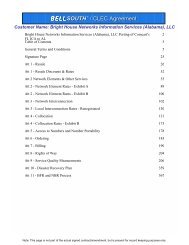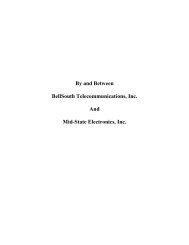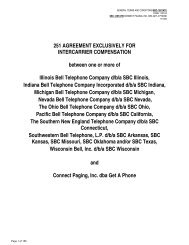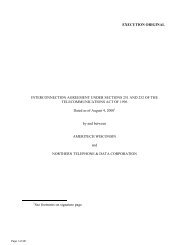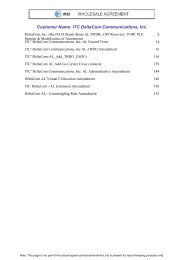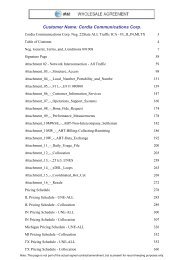Access One Communications, Inc.
Access One Communications, Inc.
Access One Communications, Inc.
You also want an ePaper? Increase the reach of your titles
YUMPU automatically turns print PDFs into web optimized ePapers that Google loves.
Version: 4Q04 Resale Agreement<br />
12/14/04<br />
Resale Agreement<br />
Attachment 5<br />
Page 7<br />
f) Begin aggregating traffic to a location near the damaged building. From this location,<br />
begin re-establishing trunk groups to the CLECs for the delivery of traffic normally<br />
found on the direct trunk groups. (This aggregation point may be the alternate access<br />
tandem location or another CO on a primary facility route.)<br />
5.2.4 Loss of a Facility Hub<br />
In the event that BellSouth loses a facility hub, the recovery process is much the same as above.<br />
Once the NMC has observed the problem and administered the appropriate controls, the ECC will<br />
assume authority for the repairs. The recovery effort will include<br />
a) Placing specialists and emergency equipment on notice;<br />
b) Inventorying the damage to determine what equipment and/or functions are lost;<br />
c) Moving containerized emergency equipment to the stricken area, if necessary;<br />
d) Reconnecting service on a parity basis for Hospitals, Police and other emergency<br />
agencies or End Users served by BellSouth or CLEC in accordance with the TSP priority<br />
restoration coding scheme entered in the BellSouth Maintenance database immediately<br />
prior to the emergency; and<br />
e) If necessary, BellSouth will aggregate the traffic at another location and build<br />
temporary facilities. This alternative would be viable for a location that is destroyed and<br />
building repairs are required.<br />
5.3 COMBINED OUTAGE (CLEC AND BELLSOUTH EQUIPMENT)<br />
In some instances, a disaster may impact BellSouth's equipment as well as the CLECs'. This<br />
situation will be handled in much the same way as described in Section 5.2.3. Since BellSouth<br />
and the CLECs will be utilizing temporary equipment, close coordination will be required.<br />
6.0 T1 IDENTIFICATION PROCEDURES<br />
During the restoration of service after a disaster, BellSouth may be forced to aggregate traffic for<br />
delivery to a CLEC. During this process, T1 traffic may be consolidated onto DS3s and may<br />
become unidentifiable to the Carrier. Because resources will be limited, BellSouth may be forced<br />
to "package" this traffic entirely differently than normally received by the CLECs. Therefore, a<br />
method for identifying the T1 traffic on the DS3s and providing the information to the Carriers is<br />
required.<br />
CCCS 76 of 85




